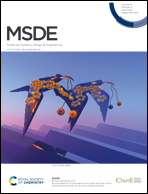In silico study of the binding of daunomycin and phenylalanine transfer RNA: probe molecular recognition for structure-based drug design†
Abstract
Rational designs of pharmaceutical compounds targeting specific RNAs require a comprehensive understanding of molecular recognition mechanisms. Knowledge of binding affinity and specificity can be gained via computational modeling and simulation techniques. In this work, an integrated computational strategy combining QM calculation, molecular docking, conventional and adaptive steered MD simulations, and the var-MM/GBSA approach was proposed to probe the binding behaviors of daunomycin (DAU) and phenylalanine transfer RNA (tRNAPhe) at a micro-scale level. Gathering experimental information enables us to eliminate improper predictions for the binding of DAU and tRNAPhe, and the calculations of PMF and ΔGbinding lead to the identification of the binding structure of the complex. Further, structural and energetic analysis of the DAU:tRNAPhe complex revealed that daunomycinone of DAU contributes the intermolecular VDW energies to nucleotides G15, C48 and U59 on tRNAPhe, responsible for the binding specificity; meanwhile daunosamine contributes the intermolecular ELE + EGB energies to U50, responsible for the binding affinity.



 Please wait while we load your content...
Please wait while we load your content...